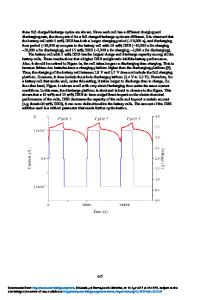Temperature Gradient Enhancement of Solid State Battery Performance
- PDF / 261,478 Bytes
- 6 Pages / 420.48 x 639 pts Page_size
- 19 Downloads / 837 Views
TA
TB
II S
Soc. Symp.
III Fig. 1.
Proc. Vol.
TB, ELECTROLYTE (C)
ANODE (B)
WIRE (A)
Mat. Res.
TB
WIRE (A')
CATHODE (B')
OVI V OIV Nonisothermal galvanic cell.
20 (1983)
TA
TB1
@Elsevier Science Publishing Co.,
OVII
Inc.
VIII
254 The measurable emf is
E = (
-
AHET = (0VII - oVI)+
The heterogeneous contribution to E is
).
-VIII
(0VI - OV) + (OIV-0III) + (0III
01)'
(1)
and the homogeneous contribution is 0HOM = (ýVIII - ýVII) + (OV-
OIV) + (011 - 01)
(2)
with
E = A0=
(viii - 1
= AHET &)
+ A oM
(3)
The model electrolyte is CaO-doped CeO2 [2] (Fig. 2) extending from x= -½L to x= ½L. The partial pressure of oxygen in the vicinity of the anode, 0IV PO2' is 10-20 atm, while the partial pressure in the vicinity of the cathode,
ANODE (B)
CATHODE (B')
ELECTROLYTE CeO2
(C)
IV -20 02 PI0 = 10 atm
J
-½L Fig. 2.
V P02 = 0.21 atm
---- +
J2
+½L
Doped CeO2 cell.
V PO 2 , is 0.21 atm. We assume that the crystalline electrolyte exhibits only vacancy disorder. We assume our crystalline electrolyte to be isotropic and write for the material fluxes Ji [41 -Jl = k11 (dTil/dx)+ k12 (dT
2 /dx)
+ k1Q (d in T/dx)
,
-J2 = k21 (dTi/dx) + P22 (dT52/dx) + k2Q (d in T/dx) , -JQ = kQ1 (dTi5/dx) + kQ2 (dT5 2 /dx) +
in T/dx) , (QQ(d
(4)
where the subscript 1 indicates a vacancy and the subscript 2 indicates an The kij are electron. The Ca atom framework (U=3) is the reference frame. The conjugate generalized forces are Onsager coefficients, with (d in T/dx) and (dT~i/dx) = (Ai/dx') + Si(dT/dx), where Ti is partial molar entropy. Since our system is dilute and the Ca framework is fixed, all activity coefficients may be set equal to 1, and the reference velocity (v 3 ) is zero. With neglect of cross terms (k12), the Nernst-Planck equations result [5), -J1 = 9 11(dTDl/dx) + 91Q (d in T/dx) , -J2 = £ 2 with
2
(dTJ 2 /dx) + R2 Q (d ln T/dx)
,
(5)
255 (d
1
= kT(d ln Nj/dx) + qz.(d4/dx) .
j/dx)
(6)
where N is the concentration of ion j, zj is the effective charge of species j, relative to the ideal lattice, q is the electronic charge, 4 is the electric In terms of the mobilities ui and potential, and k is Boltzmann's constant. the diffusivities Di [51, Eqs. (5) become -Jl = D1 (dN1 /dx) -J2 = D2
(dN2 /dx)
+ N1 ul (d4/dx) + (N 1 UlQl/2q) (d ln T/dx) - N2 u2 (do/dx) + (N2 u2 Q2 /q) (d ln T/dx)
,
(7)
where Qi = TkQi /ii* CALCULATION OF EFFICIENCY The current delivered to the load is I= 2qJl-qJ 2 = Ii+1 2 . The efficiency rj To (A0/ApREV), where AOREV is the Nernst potential. is defined by n = (I/Il) obtain the electrochemical contribution to A0, namely (OV-0IV) , we solve Eqs. (7) for (do/dN2 ) and integrate the result. estimate of the effect of a temperaFor simplicity in obtaining this first ture gradient on the efficiency, we assume a linear temperature distribution A more refined [6], T=TM+ (x/L)AT, with TM=½(TB+TBI), and AT= (TBi-TB). treatment would start from the energy conservation law in the form 0
X-i12 + (d/dx)[K(dT/dx)]
(8)
,
For A where X is the electrical conductivity
Data Loading...











